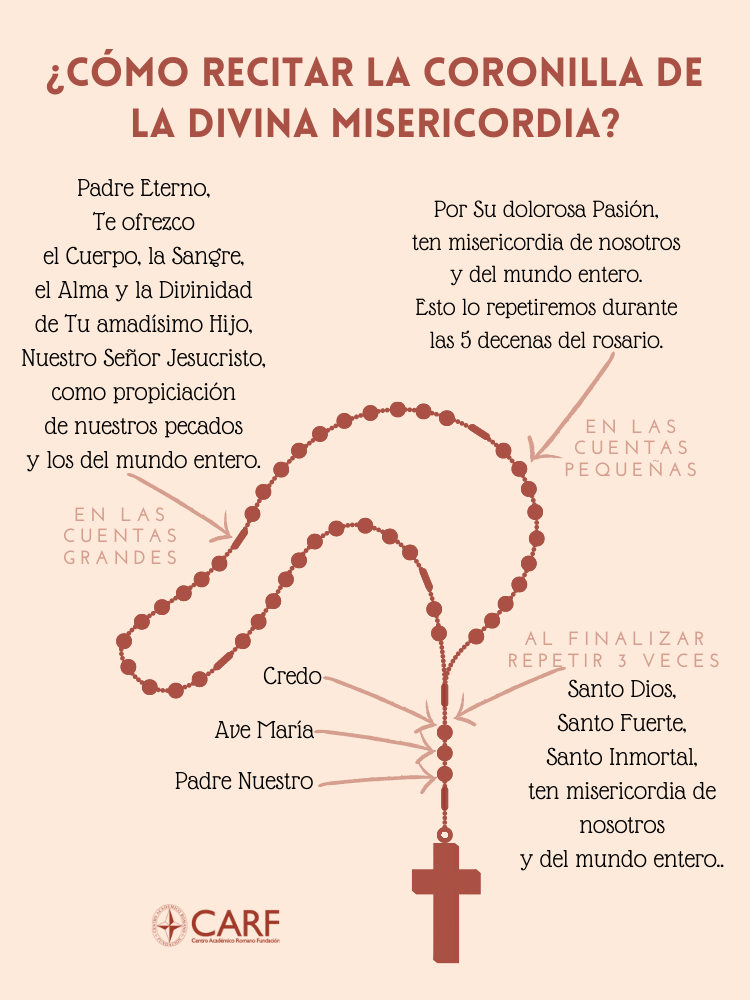
The devotion to the Divine Mercy, consists of a set of prayers generally prayed with the help of a rosary, although they can easily be done without it because of its simplicity.
Jesus appears to St. Faustina on September 14, the feast of the Exaltation of the Holy Cross, to teach her the Chaplet of Divine Mercy.
Sister Faustina KowalskaShe received the message of God's mercy from a vision she had in 1935. The saint recorded the vision in her diary. And little by little she began to spread the prayer that Jesus himself taught him.
It asks for trust in God and an attitude of mercy towards our neighbor. The prayer calls to proclaim and pray for Divine Mercy for the world.
"When you pray this Tertius with the dying, I will stand between the Father and the dying soul, not as a just Judge, but as a Merciful Savior." Diary of Saint Faustina
With these words we see, once again, how Jesus comes to meet us again and again. In his infinite love we see throughout history how he fulfills this promise to stay with us until the end.
Devotion to the Divine Mercy grew very rapidly after the beatification (April 18, 1993) and canonization (April 30, 2000) of Sister Faustina and also due to the pilgrimages of Pope John Paul II to Lagiewniki (1997 and 2002).
When Pope John Paul II canonized St. Faustina in 2000, during the ceremony he declared: "It is therefore important that we fully embrace the message transmitted to us by the Word of God on this Second Sunday of Easter, which will henceforth be known throughout the Church as Divine Mercy Sunday. Homily, April 30, 2000.
Both Benedict XVI and Pope Francis have recommended this devotion.
"Encourage people to say the Chaplet I have given you (...) Whoever recites it will receive great mercy at the hour of death. Priests will recommend it to sinners as their last refuge of salvation. Even if the most hardened sinner has recited this Chaplet at least once, he will receive the grace of My infinite Mercy. I desire to grant unimaginable graces to those who trust in My Mercy."
Diary of Saint Faustina

Guide for reciting the Chaplet.
The recitation of the Chaplet to the Divine Mercy is preceded by two prayers taken from the Diary of St. Faustina and followed by a final prayer.
To recite the Chaplet of Divine Mercy, use a normal Rosary and follow this sequence
With a common 5-decade rosary in hand, we begin this chaplet:
The sign of the Cross
Our Father
Ave Maria
Credo
The first three beads of the Rosary can be used for this part.
At each major grain of the Rosary, where we usually pray the Our Father, we will pray the following prayer:
Eternal Father,
I offer you
the Body, the Blood,
Soul and Divinity
of Your most beloved Son,
Our Lord Jesus Christ,
as propitiation
of our sins
and those of the entire world.
At each minor grain of the Rosary, where we usually pray the Hail Mary, we will say the following prayer:
For His painful Passion,
have mercy on us
and the whole world.
We will repeat this during the 5 decades of the rosary.
At the end of the 5 decades of the rosary, with the aforementioned prayers, we will recite the following final prayer three times in a row
Holy God,
Santo Fuerte,
Immortal Saint,
have mercy on us
and the whole world.
O Eternal God, in whom mercy is infinite and the treasury of compassion inexhaustible, turn to us Thy gracious gaze and increase Thy mercy in us, so that in difficult times we may not despair or become discouraged, but with great confidence submit to Thy holy will, which is Love and Mercy itself.
Amen.
We conclude with the sign of the Cross: In the name of the Father and of the Son and of the Holy Spirit, Amen.
St. Faustina Kowalska with the image of the Divine Mercy. It is an extraordinary image, not only because it is so well known in so many countries. Jesus appeared to St. Faustina showing Himself as He appears in the image when she was in her cell in the convent of the Congregation of the Sisters of the Mother of God of Mercy in Plock on February 22, 1931. There Jesus asked her to paint this image.
This Chaplet can be prayed at any time, but our Lord specifically asked that it be recited in the form of a novena, in a special way, during the nine days preceding the Feast of Mercy.
During this novena, the Lord said to St. Faustina: "During this novena, I will grant souls all kinds of graces. Diary of Saint Faustina
We can pray this novena for our own particular intentions or we can offer it together with the Novena for the daily intentions dictated by our Lord to St. Faustina.
If we pray with confidence the novena that Jesus asked of Sister Faustina, we will be able to obtain, by virtue of the confidence we have, graces, since there is a concrete promise linked to the prayer of the novena.
Bibliography:
Opusdei.org
santafaustina.es